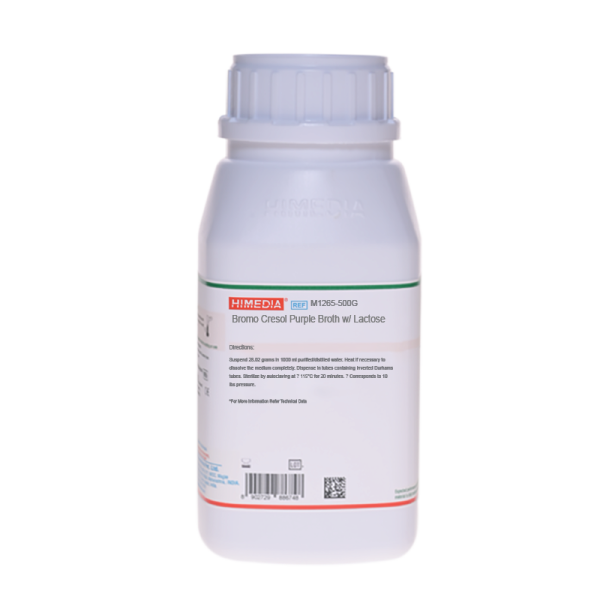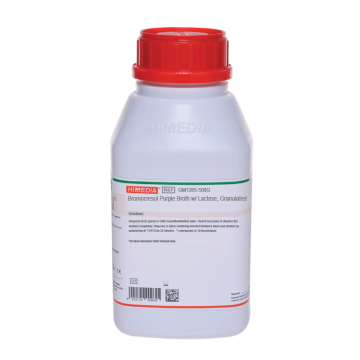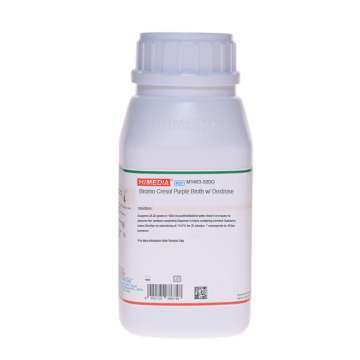 Your enquiry has been submitted
Your enquiry has been submitted
Bromo Cresol Purple Broth w/ Lactose
Water#CC293D
Intended Use
Recommended for identification of Escherichia coli and coliform bacteria from water samples.
Composition**
| Ingredients | g/L |
|---|---|
| Peptone | 10.000 |
| HM extract # | 3.000 |
| Sodium chloride | 5.000 |
| Lactose | 10.000 |
| Bromo cresol purple | 0.020 |
Final pH (at 25°C): 7.2±0.2
**Formula adjusted, standardized to suit performance parameters
# Equivalent to Meat extract
Directions
Suspend 28.02 grams in 1000 ml purified/distilled water. Heat if necessary to dissolve the medium completely. Dispense in tubes containing inverted Durhams tubes. Sterilize by autoclaving at A 115°C for 20 minutes.
▲ Corresponds to 10 lbs pressure.
Principle And Interpretation
The coliform group of bacteria is the principal indicator of suitability of water for domestic, industrial or other uses. The coliform group density has been established as a criterion of the degree of pollution and thus of sanitary quality. Faecal Streptococci and Enterococci are also indicators of faecal pollution (1). Where it is claimed that drinking water has been processed for safety, the finding of such organism demonstrates a failure of the process. It is a valuable bacterial indicator for determining the extent of faecal contamination of recreational surface waters or drinking water (2).
Bromo Cresol Purple Broth with Lactose is used for the identification of Escherichia coli and coliforms from water. It is used for enrichment and determining the titre of coliforms in the bacteriological analysis of drinking water (3,4). The medium contains Peptone and HM extract, which supplies the essential nutrients for E. coli and other coliforms. Sodium chloride maintains the osmotic equilibrium of the medium. Lactose upon fermentation by coliforms produce acid and is indicated by the pH indicator bromocresol purple. It turns yellow at acidic pH.
Type of specimen
Water samples
Specimen Collection and Handling
For water samples, follow appropriate techniques for sample collection, processing as per guidelines and local standards (1). After use, contaminated materials must be sterilized by autoclaving before discarding.
Warning and Precautions
Read the label before opening the container. Wear protective gloves/protective clothing/eye protection/ face protection. Follow good microbiological lab practices while handling specimens and culture. Standard precautions as per established guidelines should be followed while handling specimens. Safety guidelines may be referred in individual safety data sheets.
Limitations
- Individual organisms differ in their growth requirement and may show variable growth patterns on the medium.
Performance and Evaluation
Performance of the medium is expected when used as per the direction on the label within the expiry period when stored at recommended temperature.
Quality Control
Appearance: Cream to yellow homogeneous free flowing powder
Colour and Clarity of prepared medium: Purple coloured clear solution without any precipitate
Reaction: Reaction of 2.8% w/v aqueous solution at 25°C. pH: 7.2±0.2
pH: 7.00-7.40
Cultural Response: Cultural characteristics observed after an incubation at 35-37°C for 18-24 hours.
| Organism | Growth | Acid | Gas |
|---|---|---|---|
| Escherichia coli ATCC 25922 (00013*) | good-luxuriant | positive reaction, yellow colour | positive |
| Enterococcus faecalis ATCC 29212 (00087*) | fair-good | variable reaction | negative reaction |
| Klebsiella pneumoniae ATCC 13883 (00097*) | good-luxuriant | positive reaction, yellow colour | positive reaction |
| Salmonella Typhimurium ATCC 14028 (00031*) | good-luxuriant | negative reaction, no colour change | negative reaction |
Key: (*) Corresponding WDCM numbers.
Storage and Shelf Life
Store between 10-30°C in a tightly closed container and the prepared medium at 15-30°C. Use before expiry date on the label. On opening, product should be properly stored dry, after tightly capping the bottle in order to prevent lump formation due to the hygroscopic nature of the product. Improper storage of the product may lead to lump formation. Store in dry ventilated area protected from extremes of temperature and sources of ignition. Seal the container tightly after use. Product performance is best if used within stated expiry period.
Disposal
User must ensure safe disposal by autoclaving and/or incineration of used or unusable preparations of this product. Follow established laboratory procedures in disposing of infectious materials and material that comes into contact with sample must be decontaminated and disposed of in accordance with current laboratory techniques (5,6).
Reference
- Lipps WC, Braun-Howland EB, Baxter TE,eds. Standard methods for the Examination of Water and Wastewater, 24th ed. Washington DC:APHA Press; 2023.
- Corry J. E. L., Curtis G. D. W., and Baird R. M., Culture Media for Food Microbiology, Vol. 34, Progress in Industrial Microbiology, 1995, Elsevier, Amsterdam.
- Deutsche Einheitsverfahren zur Wasser- Abwasser- und Schalmmuntersuchung. VCH Verlagsgesellschaft, D-6940, Weinheim.
- Verordnung über Trinkwasser und über Wasser für Lebensmittelbetriebe vom 12. Dezember, 1990, Bundesgesetzbl., Teil I;2613-2629.1990.
- Isenberg, H.D. Clinical Microbiology Procedures Handbook 2nd Edition.
- Jorgensen, J.H., Pfaller, M.A., Carroll, K.C., Funke, G., Landry, M.L., Richter, S.S and Warnock., D.W. (2015) Manual of Clinical Microbiology, 11th Edition. Vol. 1.
| Product Name | Bromo Cresol Purple Broth w/ Lactose |
|---|---|
| SKU | M1265 |
| Product Type | Regular |
| Physical Form | Powder |
| Origin | Animal |
| Packaging type | HDPE |
| References | 1. Eaton A. D., Clesceri L. S. and Greenberg A. E., (Eds), 1998, Standard Methods for the Examination of Water and Waste water, 20th Ed, APHA, Washington, D.C. |
| Customized Product Available | No |






